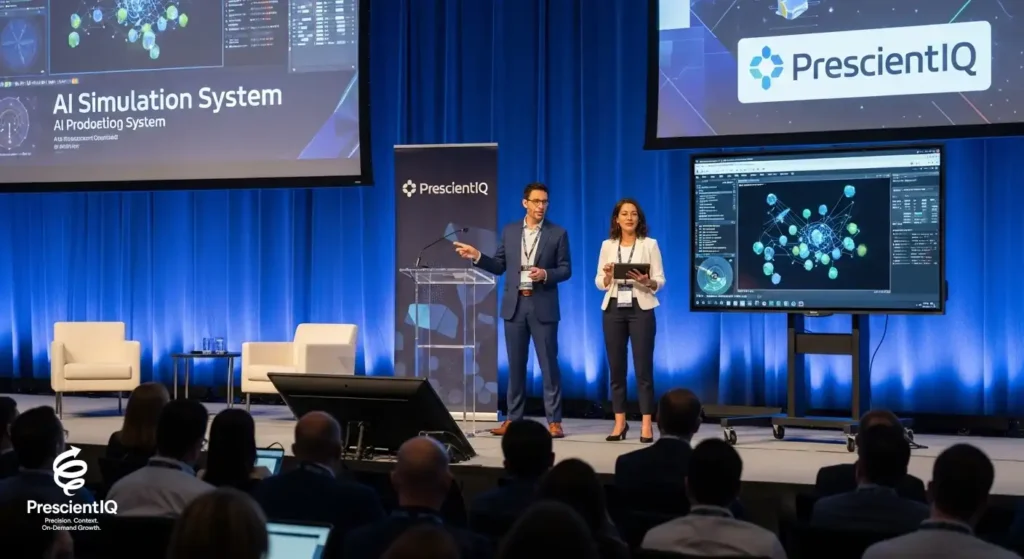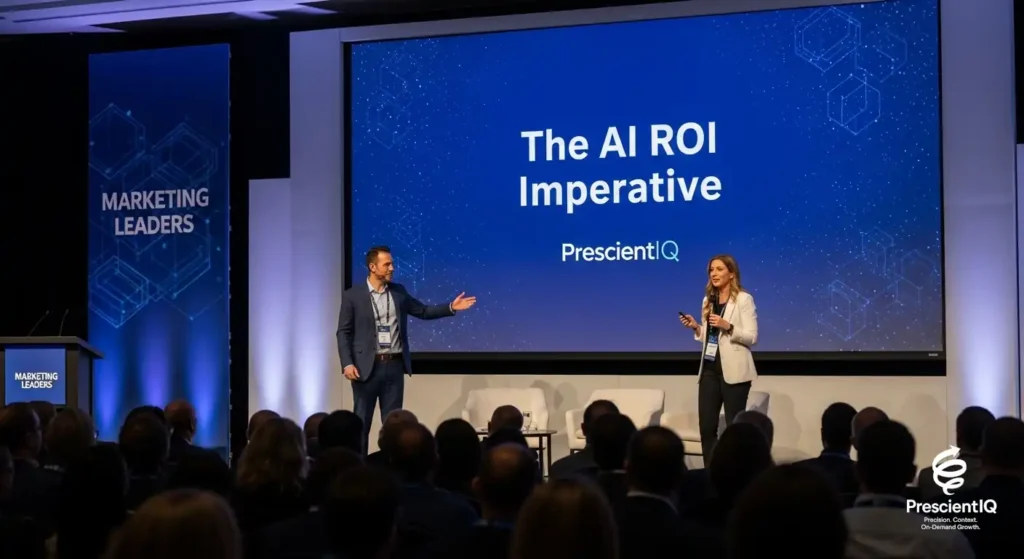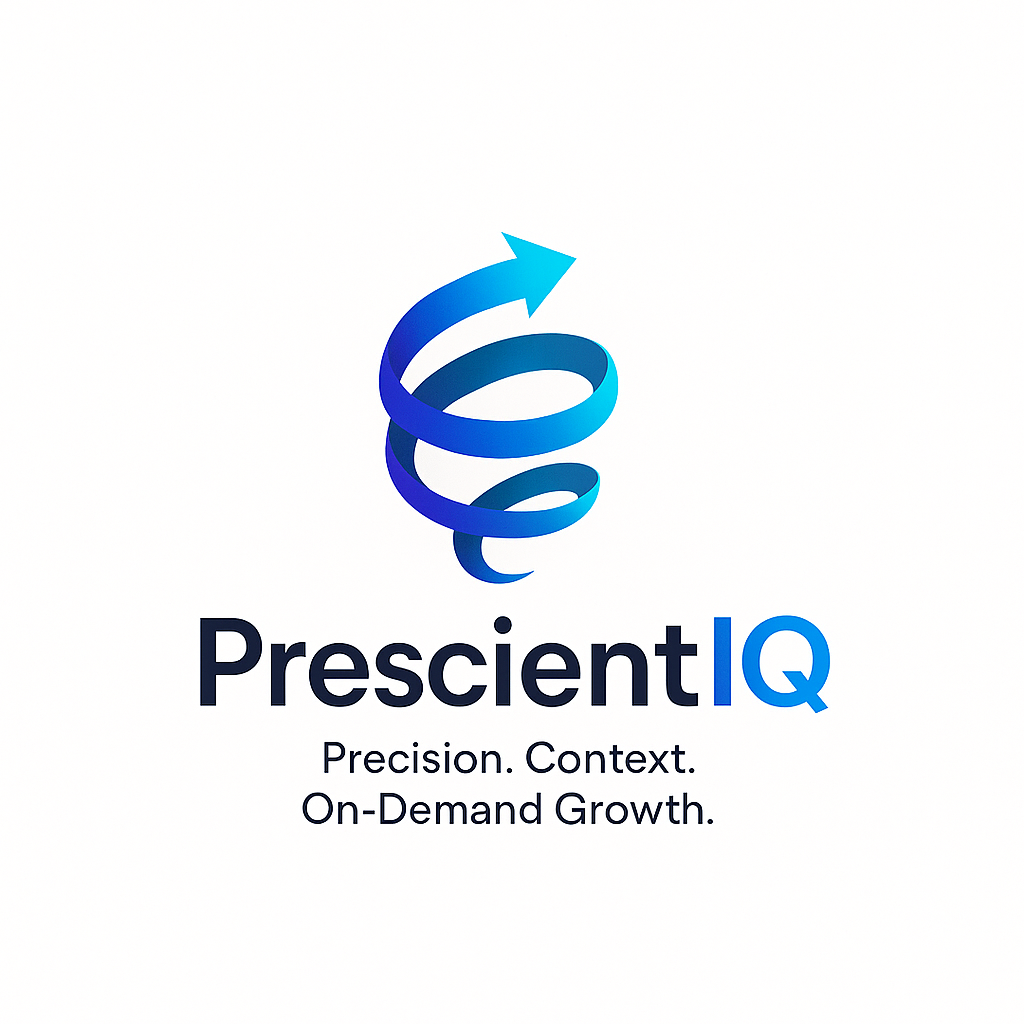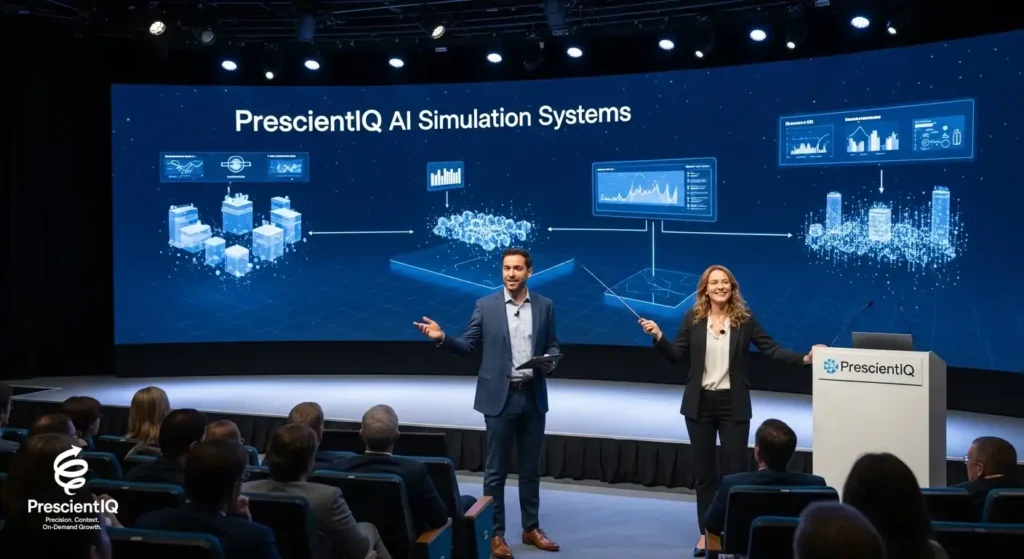AI Simulation Systems: The New Growth Engine for Marketing Leaders
Learn How to Use an AI Simulation System: The New Growth Engine for Marketing Leaders
The Moment Every CMO Feels
You’ve seen it before.
A campaign that looked flawless on paper—perfect creative, strong media plan, glowing analytics—falls flat in the market.
Engagement drops. Conversions lag. Customers disengage. The pressure mounts.
In today’s fast-moving landscape, where customers demand personalization before they even know what they want, every marketing decision carries risk.
CMOs and marketing leaders are expected to predict behavior, drive growth, and deliver flawless customer experiences—all while budgets shrink and complexity grows.
Imagine if you could test every campaign, pricing model, and customer journey before launch. Imagine seeing how your audience would react and why they respond the way they do—without spending a single marketing dollar in the real world.
That’s what AI Simulation Systems make possible.
The Breakthrough: AI Simulation Systems

An AI Simulation System is a next-generation intelligence platform that combines large language models (LLMs), semantic AI search, and reinforcement learning to create virtual environments where marketing teams can simulate customer behavior, test decisions, and optimize strategies—long before deployment.
These systems replicate real-world conditions using synthetic data, digital twins, and AI-driven predictive modeling.
In essence, you’re giving your marketing team a safe, virtual sandbox where ideas evolve, risks disappear, and outcomes are forecasted with uncanny accuracy.
It’s not about replacing the marketer. It’s about empowering them with AI foresight—a predictive lens that turns instinct into science.
Stop getting your AI budget cut: Move beyond “efficiency” to provable P&L impact.
Core Concept: Visually contrast the failed “efficiency-only” pitch (which collapses into a Strategic Value Black Hole) with a 4D Value Framework that ties AI to revenue, pipeline, enterprise value, and risk reduction.
The Strategic Value Black Hole
Cost-only logic collapses your business case. Efficiency ≠ investment thesis.
A 5% boost in “Lead Scoring Accuracy” = $12M in Qualified Pipeline.
Tie model accuracy to increased Sales-Accepted Leads and win-rate lift.
A 10% lift in “Cross-Sell Conversion” from AI = $45M in New Revenue.
Translate conversion lift into additional orders, margins, and P&L impact.
A 20% increase in “Customer Lifetime Value (CLV)” from AI-personalization = $100M in Enterprise Value.
Convert CLV gains into discounted cash flows the CFO recognizes.
AI-driven compliance in ad-targeting = $8M in Fines Avoided.
Model compliance avoidance as preserved operating income.
Why CMOs Are Turning to Simulation
Every marketing leader wants the same three outcomes:
- Higher customer satisfaction — by understanding what customers value emotionally and functionally.
- More sales revenue — by predicting which messages, offers, and channels drive conversion.
- Less waste — by testing and refining before launch.
AI Simulation Systems deliver all three.
They use AI search to surface the right knowledge instantly, LLMs to understand natural language and emotion, and simulation modeling to predict behavior across customer segments.
Where traditional analytics explain what happened, simulation tells you what will happen next.
How AI Simulation Works — The Engine Beneath the Innovation

Here’s how it comes together:
- Data Ingestion & Contextualization
The system pulls structured and unstructured data—from CRMs, websites, ads, and social signals—and feeds it into an LLM trained for marketing contexts. - Semantic AI Search
Instead of relying on keywords, semantic search understands intent and meaning.
When you ask, “What message will resonate with first-time buyers in healthcare?” it draws on customer data, industry reports, and historical campaigns. - Simulation Modeling
The AI then creates digital twins of your target customers and market conditions. It models how they’ll respond to specific offers, creative elements, or pricing strategies. - Feedback Loop & Reinforcement Learning
The system continuously refines itself through feedback loops, learning which strategies maximize satisfaction and conversion.
The result?
A living, learning, predictive marketing environment with AI Simulation Systems.
The Emotional Payoff: Confidence in Every Decision
For CMOs, confidence is currency.
Every pitch to the board, every media investment, every strategy depends on belief in the data.
AI Simulation restores that confidence. It replaces “I think” with “I know.”
It allows marketers to act on emotional intelligence at scale—combining human empathy with machine precision.
Where AI Delivers Measurable Value
Top three, battle‑tested benefits per industry. Use this as a leave‑behind or slide insert.
- 1Faster diagnosis & triage
- 2Clinical documentation
- 3Claims automation
- 1Fraud detection
- 2Risk scoring & AML
- 3Personalized insights
- 1Demand forecasting
- 2Product recommendations
- 3Inventory optimization
- 1Predictive maintenance
- 2Vision quality checks
- 3Yield optimization
- 1Route & load optimization
- 2Accurate ETAs
- 3Warehouse automation
- 1Load forecasting
- 2Asset monitoring
- 3Anomaly detection
- 1Lead scoring
- 2Campaign optimization
- 3Content generation
- 1Resume screening
- 2Attrition prediction
- 3Workforce planning
- 1Self‑service assistants
- 2Case summarization
- 3Sentiment routing
| Industry | Top AI Benefits |
|---|---|
| Healthcare | |
| Financial Services | |
| Retail & eCommerce | |
| Manufacturing | |
| Logistics & Supply Chain | |
| Energy & Utilities | |
| Marketing & Sales | |
| HR & Talent | |
| Customer Support |
Industry Use Cases: How AI Simulation is Rewriting Marketing Playbooks
1. Technology: Accelerating B2B Sales
Tech buyers are notoriously complex. They research, compare, and question every feature. AI Simulation Systems let technology marketers build virtual buyer personas—LLM-driven models that simulate enterprise decision-making patterns.
In one SaaS company, the marketing team used AI simulation to test different messaging angles for a product launch.
By analyzing synthetic buyer responses, the system predicted that emphasizing data privacy and ease of integration would outperform feature-focused messaging by 31% in conversion potential.
They adjusted the campaign pre-launch—and hit their targets early.
Outcome: Faster time-to-market, higher lead conversion, and reduced acquisition cost. Learn about sales pipeline metrics that drive growth.
2. Manufacturing: The Rise of Predictive Sales and Marketing
In the manufacturing sector, sales cycles are long, and decisions involve multiple stakeholders.
AI simulation creates digital twins of buyers and distributors, enabling marketing leaders to model their decision-making processes before engaging in real-world interactions.
One industrial manufacturer used simulation to predict which sustainability narratives would resonate with OEM partners.
The simulation revealed that highlighting the impact of carbon reduction over cost savings would generate deeper brand affinity.
Result: A 40% increase in partner engagement and 23% faster deal closures.
3. Financial Services: Building Trust Through Predictive Personalization
Financial customers make decisions based on emotion and trust, not just numbers.
AI simulations in banking and wealth management model emotional triggers such as risk comfort, trust levels, and perceived expertise.
A mid-tier financial services brand tested client interaction scripts in simulation—adjusting tone, empathy, and word choice using LLM-powered behavioral analysis.
The optimized script led to a 17% increase in client retention and a 25% rise in cross-sell opportunities.
Simulation revealed something no spreadsheet could:
The words that build confidence are the words that build loyalty.
4. Healthcare: Humanizing Patient Engagement
In healthcare, personalization is not just a KPI—it’s a responsibility.
AI simulation systems help marketing teams understand the psychology of patient decision-making by simulating empathy-driven messaging.
A large telehealth provider simulated patient onboarding conversations and tested how tone, clarity, and reassurance affected engagement.
The simulation revealed that messages focusing on ease of access and human warmth outperformed generic clinical messaging by 52%.
Impact: Higher patient trust scores, increased adoption, and stronger lifetime value.
5. Hospitality: Perfecting Guest Journeys
Hospitality thrives on emotion.
AI simulation allows marketers to create digital guests—each with preferences, emotions, and spending habits—to test offers and experiences.
One global hotel brand used simulations to test loyalty campaign variants across demographics.
By modeling sentiment responses, they found that guests responded most positively to campaigns that used personalized storytelling rather than discounts.
Outcome: A 28% increase in loyalty enrollment and a measurable rise in guest satisfaction scores.
6. Professional Services: Training High-Performance Teams
Professional service firms thrive on human interaction—pitch meetings, client conversations, proposal presentations.
Simulation transforms training into a data-driven, empathetic experience.
Consulting firms now use AI simulation to replicate client objections and negotiations, allowing teams to practice persuasive communication with AI-generated clients.
These “virtual clients” mirror the personalities of real decision-makers, giving professionals a safe practice environment before real-world engagements.
Result: Measurable improvements in win rates and client satisfaction.
The Deeper Value: Connecting Emotion to Revenue
Every marketer knows that emotion drives decisions, not logic.
AI Simulation Systems quantify emotional data—showing not only what works, but why.
When marketers simulate audience responses, they uncover emotional patterns:
- Which messages spark curiosity
- Which visuals inspire confidence
- Which offers feel authentic vs manipulative
By aligning messaging with emotional resonance, brands see:
- Higher satisfaction scores
- Deeper loyalty
- Longer lifetime value
- Increased revenue per customer
AI simulation doesn’t just optimize marketing. It humanizes it.
The ROI Equation for the Modern CMO
Here’s how simulation transforms performance:
| Metric | Traditional Marketing | With AI Simulation |
| Campaign Testing | Post-launch A/B | Pre-launch AI sandbox |
| Customer Understanding | Demographic-based | Emotion + behavior modeling |
| Optimization | Reactive | Predictive + self-learning |
| Conversion Improvement | 5–10% typical | 25–40% achievable |
| Budget Efficiency | Moderate | 30–50% reduction in waste |
Every dollar spent in simulation saves multiple dollars in deployment.
That’s how CMOs are finally aligning creativity with commercial impact.
How Aether De-Risks Enterprise AI Adoption
Speed to Value
From 9-Month PoC to 14-Day Validation. Our Simulation-First motion delivers quantifiable insights in < 14 business days, crushing the traditional time-to-value.
Quantifiable ROI
Know Your ROI Before You Buy. Aether provides a non-binding, good-faith estimate of your specific cost savings and efficiency gains, turning a budget gamble into a predictable business case.
Uncompromising Security
Enterprise-Grade Data Governance. Your data remains your property. It is never used for training, is isolated in a single-tenant sandbox, and is permanently purged post-simulation.
See your future, first.
The Human Element: Empowering Teams, Not Replacing Them
Let’s be clear—AI simulation isn’t about automating marketing. It’s about amplifying marketers.
It gives CMOs and their teams a virtual playground for innovation.
Instead of fearing mistakes, they can embrace experimentation.
Instead of relying on static dashboards, they gain living insights that evolve with every data point.
AI becomes the coach, the guide, the invisible strategist—empowering human creativity with machine precision.
The Future: Predictive Marketing as the New Standard
The next decade of marketing belongs to those who can predict before they act.
AI simulation will evolve into a central intelligence layer connecting customer data, creative strategy, and market execution.
Imagine a future where:
- Every campaign runs through a simulation before launch.
- Every customer journey is stress-tested for its impact on satisfaction.
- Every decision is backed by emotional analytics, not assumptions.
That’s not science fiction—it’s this year’s competitive advantage.
A CMO’s Start with AI Simulation Systems Before You Spend Money.
If you’re a marketing leader standing at the crossroads of uncertainty and innovation, now is your moment.
AI Simulation Systems offer more than analytics—they offer clarity.
They give you a way to test, adapt, and lead with confidence. They restore creativity without risk, and data without doubt.
Your customers deserve experiences that feel intuitive, personal, and real. Your brand deserves strategies that win before the first dollar is spent.
This is the future of marketing leadership—predictive, empathetic, and powered by AI simulation.
Final Word on AI Simulation Systems
In the age of digital acceleration, CMOs who thrive won’t be the ones with the biggest budgets.
They’ll be the ones with the boldness to simulate, learn, and adapt faster than the competition.
AI Simulation Systems are the key.
They’re how you turn marketing from a guessing game into a growth engine—From campaigns that hope to work to strategies that will.
Because in marketing, the greatest advantage isn’t data. It’s foresight.
And with AI simulation, foresight becomes your greatest asset.
Redefine Value: From Efficiency to Autonomy
ROI must evolve from “time saved” to “autonomous value created.” Agentic systems redefine productivity as an outcome rather than an input—multiplying functions without human dependency.
Outcome over input
Leaders should assess not only how AI improves processes, but how it can independently replace or multiply functions across the org.
Old → New
Quick framing
A simple way to think about it:
Autonomy ROI ≈ Agent-generated value ÷ Compute & orchestration cost
Track it as a product metric—not just an ops metric.

